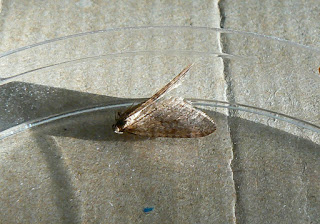Now that I'm finally up-to-date with my own records for the year, here are a few statistics from the garden at Westcott:
Nights trap was run (to 7th Dec): 305, of which 188 were Actinic alone and 117 were Actinic + MV.
Species caught: 621 identified so far (343 macros and 278 micros).
Nights with 100+ species: 19 (18 using both traps, 1 using Actinic alone), down from 26 in 2018.
Best night: 23rd July (1,217 moths of 158 species; 768 of 137 spp to MV & 449 of 97 spp to Actinic).
Highest count for a single species: Heart & Dart for macros (4,975 individuals),
Agriphila tristella for
micros (1,995 individuals).
New for the site in 2019: at least 20 species, 11 of them macros (Red-tipped Clearwing, Birch Mocha,
Oblique Carpet, Netted Pug, Bordered White, Barred Red, Dewick's Plusia, Crescent, Twin-spotted
Wainscot, Suspected & Oak Rustic).
Total number of moths caught in the garden in 2019: 55,212 (to 7th Dec).
When complete, dissections will add to some of these totals, particularly the number of micro species seen in the garden during the year which should eventually exceed 300 by a fair margin.
The thing which stands out the most from these statistics is the final one in the list above, the overall number of moths caught. The previous highest annual total here was 42,062 (in 2018). There was a
substantial increase in counts for most of the species which always appear in large numbers anyway, such as Large Yellow Underwing, Setaceous Hebrew Character and Dark Arches (perhaps surprisingly, the Heart & Dart tally wasn't actually a site record!). In addition to the other usual suspects from which I've come to expect very high numbers annually, Common Wainscot, Black Rustic & Vine's Rustic also achieved totals above 900, which is way more than usual.
Ignoring the actual totals listed above (other gardens in different habitats, perhaps trapped much less frequently, will always produce vastly different counts), did anyone else experience such a noticeable increase in overall numbers of the most abundant species during 2019? Most of those I've mentioned are noctuids which use grasses or low-growing herbaceous plants. As larvae they would have started out feeding during the late-summer of 2018 when everything was absolutely parched so it seems a bit counter-intuitive that, far from suffering thanks to that hot weather, they've actually done better than they usually do.
Dave Wilton
Westcott, Bucks















